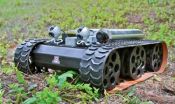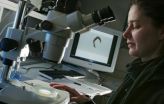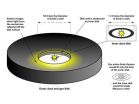(Press-News.org) TUCSON, Ariz. (February 18, 2011) -- A University of Arizona College of Engineering researcher and his team who are developing intelligent robots for planetary exploration will be featured in a segment of an upcoming episode of the science program "WaveLengths."
The robots will be featured on the episode premiering Thursday night, February 24 at 8:30 p.m. MST on public television KUAT Channel 6. "WaveLengths" is a quarterly science program hosted by BIO5 Institute Member Dr. Vicki Chandler.
The exploration robots are part of a tier-scalable, reconnaissance system prototype which would be used for planetary exploration. A team lead by Prof. Wolfgang Fink of the Department of Electrical and Computer Engineering at the UA College of Engineering developed the reconnaissance system, involving an orbiting satellite, overhead blimp, and surface level, autonomous surface rovers and sea rovers. The intelligent, free-thinking rovers would have the ability to target specific exploration areas for sample and data acquisition.
Communication between the three tiers would take just seconds instead of hours, and the satellite at the top of the tiers would be calling the shots.
The planetary exploration rovers and sea rovers generated industry excitement in November 2010 during opening exhibitions at the international MacTech conference in Los Angeles, when developers received their first public glimpse of the functionality of the Mac-based robotic platforms outside of a university or research setting.
UA Engineering's Prof. Fink is one of only a few dozen researchers who are developing robots with true high-level independence that enables them to avoid danger while investigating specific planetary features. The rovers -- which can carry payloads of 60 pounds -- are based on Mac minis and controlled by iOS devices such as the iPod Touch or iPhone. A sea exploration rover, also controllable by iOS devices, will also be featured on the Feb. 24 "WaveLengths" program.
INFORMATION:
Fink's research on the use of intelligent robots for planetary exploration has received the NASA Board Award. The tier-scalable reconnaissance paradigm and the robotic explorers were also featured in the July 2010 issue of Science magazine. More information can be found here:
Article on planetary rovers from Arizona Engineer Online
http://www.engr.arizona.edu/news/story.php?id=178
"Making Smarter, Savvier Robots," 2010 article from Science magazine
http://www.engr.arizona.edu/news/media/file/science073010e.pdf
The Department of Electrical and Computer Engineering at the UA College of Engineering
http://www.ece.arizona.edu/
Media contact
Steve Delgado, Specialist, UA College of Engineering Communications
sdelgado@engr.arizona.edu
(520) 621-2815
CREDITS FOR AVAILABLE IMAGES
Fink_titanscene_web
Fink's "Tier-Scalable Reconnaissance" concept for autonomous robotic exploration of planetary bodies is shown here applied to Saturn's moon Titan with its methane lakes. Depicted is an orbiter controlling airships or blimps, which in turn control ground rovers and lake landers or boats.
CREDIT: Image courtesy of Wolfgang Fink and Mark A. Tarbell, Visual and Autonomous Exploration Systems Research Laboratory, Department of Electrical and Computer Engineering, University of Arizona College of Engineering.
Fink_rover_web.jpg
Smarter than the average robot: One of Fink's new generation of planetary rovers.
CREDIT: Image courtesy of Wolfgang Fink and Mark A. Tarbell, Visual and Autonomous Exploration Systems Research Laboratory, Department of Electrical and Computer Engineering, University of Arizona College of Engineering.
397400main_armada
Artist's concept of orbiter, airblimps, rovers and robots working together.
CREDIT: Image courtesy of Caltech/ESA/NASA/JPL.
Planetary exploration robots to be featured on science program 'WaveLengths'
2011-02-20
ELSE PRESS RELEASES FROM THIS DATE:
Women are better at forgiving
2011-02-20
A study by the University of the Basque Country (UPV/EHU) has carried out the first Spanish study into the emotional differences between the sexes and generations in terms of forgiveness. According to the study, parents forgive more than children, while women are better at forgiving than men.
"This study has great application for teaching values, because it shows us what reasons people have for forgiving men and women, and the popular conception of forgiveness", Maite Garaigordobil, co-author of the study and a senior professor at the Psychology Faculty of the UPV, tells ...
High-volume hospitals improve orthopedic outcomes
2011-02-20
Patients who undergo elective orthopedic surgeries at high-volume, regional hospitals have better surgical outcomes and experience fewer complications than those who undergo those surgeries at local hospitals, according to research being presented by Hospital for Special Surgery investigators at the 2011 Annual Meeting of the American Academy of Orthopaedic Surgeons (AAOS).
These "regionalizers"—patients who travel to a regional, high-volume hospital—also tend to be younger, white, male and have private insurance, according to the research from Hospital for Special Surgery ...
Knee replacement surgeries take more time, are more costly in overweight individuals
2011-02-20
Knee replacement surgery takes far more time to conduct in overweight and obese patients than in normal weight patients, according to recent research at Hospital for Special Surgery in New York. The study will be presented at the American Academy of Orthopaedic Surgeons annual meeting, held Feb. 15-19 in San Diego, Calif. The study has implications for hospital staff scheduling surgeries, operating room utilization and personnel staffing, and also raises the question of whether knee replacements should be reimbursed based on time.
"When we schedule surgery, the body mass ...
Study shows PRP, commonly used technique to improve healing, doesn't work in rotator cuff surgery
2011-02-20
For years, doctors have used platelet rich plasma (PRP) to promote healing in various surgeries, but a recent study demonstrates that a type of PRP did not improve healing after rotator cuff repair. The study, conducted by Hospital for Special Surgery (HSS) investigators, will be presented at the upcoming American Orthopedic Society for Sports Medicine (AOSSM) 2011 Specialty Day meeting, held Feb. 19 in San Diego, Calif., following the annual meeting of the American Academy of Orthopaedic Surgeons.
"I would not recommend platelet-rich fibrin matrix [PRFM] as we used it ...
Study explores ability of professional dancers to return to their career after hip arthroscopy
2011-02-20
A new study has identified factors that predict the ability of a professional dancer to return to professional performance after hip arthroscopy surgery. The study by Hospital for Special Surgery investigators will be presented at the American Academy of Orthopaedic Surgeons annual meeting, held Feb. 15-19 in San Diego, Calif.
The results of this study indicated that ballet dancers were significantly less likely to be able to return to work compared with modern dancers or dance theater performers. Older age and having a variety of hip abnormalities also influenced outcome. ...
Fountain of youth from the tap
2011-02-20
(Jena, Germany) Professor Dr. Michael Ristow's team along with Japanese colleagues from universities in Oita and Hiroshima have demonstrated by two independent approaches that even a low concentration of lithium leads to an increased life expectancy in humans as well as in a model organism, the roundworm Caenorhabditis elegans. The research team presents its results in the online edition of the scientific publication European Journal of Nutrition which is now online (see hyperlink below).
Lithium is one of many nutritional trace elements and is ingested mainly through ...
Experts question aspects of prescribed burning
2011-02-20
From The Royal Botanic Gardens, Kew, The University of Western Australia, and the, Kings Park and Botanic Garden, the scientists argue that deliberately increasing the frequency of fires may lead to ecosystem degradation and loss of biodiversity.
In a paper published this month in Trends in Plant Science they acknowledge that as climate change increases the combustibility of vegetation, human lives and property are more at risk.
However, they suggest that prescribed burning – a key practice by most environmental managers – may cause more problems because, they say, ...
Back to the roots of the solar system
2011-02-20
Planets form in disks of dust and gas that surround young stars. A look at the birth places means a journey into the past of the earth and its siblings. Now, astronomers have been able to obtain detailed images of the protoplanetary disks of two stars using the Subaru telescope in Hawaii. This is the first time that disk structures comparable in size to our own solar system have been resolved this clearly, revealing features such as rings and gaps that are associated with the formation of giant planets. The observations are part of a systematic survey to search for planets ...
CeBIT 2011: Preparing for the unexpected
2011-02-20
Extreme weather, major accidents, forest fires or attacks: Citizens, rescue services and the authorities need to receive as much advance warning as possible to be able to react as quickly as possible. "Independent warning systems for each of these catastrophes and for every situation that may affect people are not feasible financially, though," observes project manager Ulrich Meissen of the Fraunhofer Institute for Software and System Technology ISST in Berlin. "In addition, that would lead to a large collection of parallel items of information that can even prove a mutual ...
UMass Amherst biologists use GPS to 'map' bats teeth to explore evolutionary adaptations to diet
2011-02-20
Using a method based on geographic positioning systems that allowed them to characterize the topography of the bats' molars in a way similar to how geographers characterize mountain surfaces, the researchers calculated a measure of dental complexity that reflects how "rugged" the surface of the tooth is. They illustrate a trend from relative simplicity of the shearing molars in insect eaters and omnivores to high complexity of the crushing molars in fruit eaters.
Working with field-collected bat skulls, researchers Sharlene Santana and Betsy Dumont of UMass Amherst, with ...




